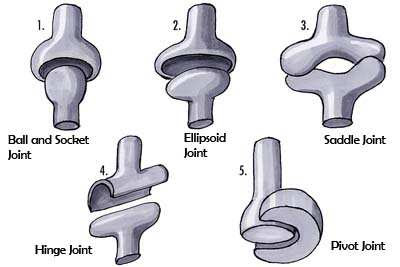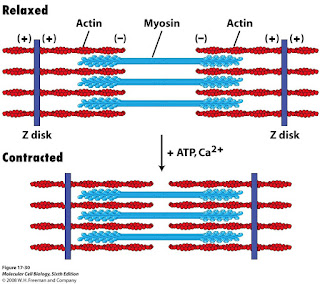This unit was primarily about the muscular system, although we started off learning about the synovial joints and movements. There are many types of synovial joint movements, but the main categories are gliding, angular, rotation, and "special" movements, which can only occur at certain joints. The types of joints that allow these motions are planar, hinge, pivot, condyloid, saddle, and ball and socket.
 |
| Synovial Joints http://www.mananatomy.com/wp-content/uploads/2010/12/synovial_joints_scheme.jpg |
Then we moved on to the muscular system, starting with the characteristics of muscles and how they are classified. Muscles serve to move bones, maintain posture, stabilize joints, and generate heat. In order to perform these actions, muscles have to have certain properties, which are contractibility (ability to shorten), extensibility (ability to elongate), and elasticity (ability to recoil). Muscle tissue is made of a different levels of fascia and muscle fibers. There is facia around each muscle fiber, fascia that wraps around bundles of fibers, and facia that surrounds the entire muscle. Each muscle has a side of origin and a side of insertion. The origin side is immovable so the insertion side can move toward the origin when contracting. Each muscle serves multiple roles depending on what type of movement it being made. There are the prime movers that cause the desired action, the antagonist that relaxes in response to the prime mover contracting, the synergists who reduce unnecessary movements, and fixators that stabilize the origin of the prime mover. Muscles are names based on a number of things: direction, size, shape, action, number of origins, and location.
Muscles contract by increasing the area that is overlapped between sarcomeres, which are sections of a myofibril aka thread of muscle fiber. Sarcomeres are composed of two types of protein filaments: actin and myosin. When a muscle is triggered by an electrical impulse, the fibers of each sarcomere slide together, making the muscle shorter. The shortening of a muscle is known as a contraction. We read an article that explained what happens physically to sarcomeres when a muscle is stretched.
 |
| Sarcomere https://static1.squarespace.com/static/55831769e4b0e3dcc327b2c3/t/57e5b3eb2994ca98e2ee6e76/1474672050384/Sarcomere |
There are three types of muscle twitch fibers that serve different purposes: slow twitch, fast twitch a, and fast twitch b. slow twitch is highly dependent on oxygen and stores little glycogen, but it is also slow to fatigue so it work well for exercises of long duration, like marathons. Fast twitch fibers are more anaerobic and quick to fatigue, to they are better suited for activities that require short bursts of energy. Genetics play the largest role in determining how much of each fiber a person has.
20 Time has been going relatively smoothly; I've learned a lot about other things unrelated to anatomy and physiology. It's a good break to work on 20 Time during class. My new year's goals are being accomplished steadily--I haven't gotten back into a consistent exercise schedule yet but I am exercising more.
No comments:
Post a Comment